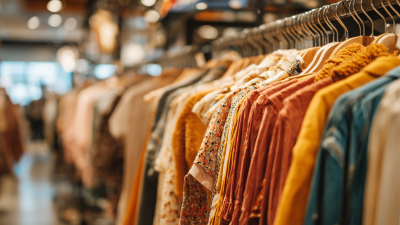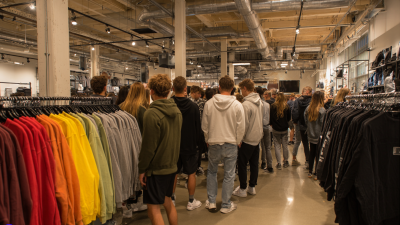Unlocking Sustainable Fashion Tips for Shopping at Your Favorite Clothing Shop
The modern era places increasing importance on sustainability, especially in the fashion industry, which has long been criticized for its environmental impact. As consumers become more conscious of their purchasing decisions, the concept of sustainable fashion emerges as a pivotal solution. This guide aims to unlock practical tips for shopping at your favorite clothing shop while fostering a sustainable mindset. By making informed choices about the brands we support, the materials we choose, and the overall practices of clothing shops, we can significantly reduce our ecological footprint. Transitioning to sustainable fashion not only involves selecting eco-friendly products but also advocating for ethical practices within the fashion industry. Join us as we explore actionable strategies that empower you to shop responsibly, ensuring that every visit to your clothing shop contributes positively to the planet and supports a more sustainable future for all.

Understanding Sustainable Fashion: Why It Matters
Understanding sustainable fashion is crucial in today’s world, where environmental concerns have become increasingly pressing. Sustainable fashion focuses on minimizing negative impacts on the environment and promoting ethical labor practices. This movement encourages consumers to consider the lifecycle of their clothing, from production to disposal, fostering a more conscious approach to fashion consumption. By choosing sustainable options, we not only help reduce waste but also support brands that prioritize environmental and social responsibility.
When shopping at your favorite clothing store, keep in mind a few tips to make your experience more sustainable. First, opt for quality over quantity; investing in timeless pieces that are durable means you won't have to replace them frequently. Second, look for brands that are transparent about their manufacturing processes and materials. Research labels that use organic or recycled fabrics, as they typically have a lower environmental footprint. Lastly, consider second-hand shopping or clothing swaps with friends, as these options extend the life of garments and reduce waste. By incorporating these practices into your shopping habits, you can contribute positively to the sustainable fashion movement.
Unlocking Sustainable Fashion Tips for Shopping at Your Favorite Clothing Shop - Understanding Sustainable Fashion: Why It Matters
| Tip | Description | Benefits | Example |
|---|---|---|---|
| Choose Natural Fibers | Opt for clothing made from organic cotton, linen, or wool. | Reduces chemical use, biodegradable. | T-Shirts made from organic cotton. |
| Support Ethical Brands | Choose brands that pay fair wages and promote good working conditions. | Supports labor rights and sustainability. | Local artisan workshops. |
| Buy Second-Hand | Thrift shopping helps reduce waste and gives clothes a second life. | Lowers demand for new production. | Buying from thrift stores or online resale platforms. |
| Care for Your Clothes | Proper washing and maintenance extends the life of clothes. | Reduces the frequency of purchases. | Using cold water and air drying. |
| Educate Yourself | Learn about sustainable practices and garments' life cycles. | Informed choices for impactful shopping. | Reading sustainability reports from brands. |
Key Principles of Sustainable Shopping in Clothing Stores
Sustainable shopping in clothing stores revolves around key principles that prioritize environmental responsibility and ethical practices. As consumers become more aware of the sustainability challenges posed by fast fashion brands, it is crucial for shoppers to adopt mindful purchasing habits. This means seeking out garments made from eco-friendly materials, supporting brands that implement sustainable manufacturing processes, and looking for those that prioritize transparency in their supply chain.

When shopping at your favorite clothing stores, consider evaluating products based on their lifecycle. Look for clothing items that are designed to last, minimizing the need for frequent replacements. Additionally, opt for brands that offer take-back programs or recycle old garments, helping to foster a circular economy. By embracing these principles, consumers can significantly contribute to redefining the fashion industry toward a more sustainable future, encouraging brands to improve their practices in response to buyer demands. The retail landscape is evolving, and with it comes the opportunity for all shoppers to influence positive change.
How to Identify Sustainable Brands and Products
Identifying sustainable brands and products can seem daunting amidst the myriad of choices available in clothing shops today. Start by looking for certifications such as Global Organic Textile Standard (GOTS) or Fair Trade, which indicate adherence to environmental and ethical standards. These labels ensure that the materials used are organic and that fair labor practices are upheld throughout the production process. Additionally, many sustainable brands openly share their sourcing and manufacturing practices, so take the time to read about a brand's mission on their website or product tags.
Another effective way to discern sustainable options is by examining the materials used in the products. Natural fibers like organic cotton, hemp, and Tencel are often more environmentally friendly than synthetic alternatives. Furthermore, consider the durability of the clothing; quality pieces that withstand the test of time contribute to sustainability by reducing the need for frequent replacements. Finally, knowing the brand’s transparency regarding their supply chain can help you make more informed choices. By focusing on these key elements, shoppers can confidently support sustainable fashion while shopping at their favorite clothing stores.
Tips for Making Eco-Friendly Choices While Shopping
When it comes to making eco-friendly choices while shopping, being a savvy consumer can greatly reduce your environmental impact. Recent studies indicate that around 300,000 tonnes of clothing are discarded every year, highlighting the urgent need for sustainable consumption practices. One simple yet effective tip is to choose quality over quantity; investing in durable, timeless pieces can reduce the frequency of shopping trips and minimize waste. Additionally, consider shopping second-hand or vintage, which not only helps to extend the lifecycle of garments but also brings unique styles into your wardrobe.
Another approach to sustainable shopping is to be mindful of the brands you support. According to industry reports, consumers are increasingly looking for transparency in materials and production methods. Focus on companies that prioritize ethical practices, use organic materials, or have a clear sustainability policy. Moreover, incorporating practices like responsible online shopping—such as avoiding excessive packaging and utilizing carbon-efficient shipping options—can further enhance your sustainable shopping habits. Remember, every small choice contributes to a larger impact, helping to pave the way for a more sustainable fashion industry.
Unlocking Sustainable Fashion: Eco-Friendly Shopping Choices
Creating a Sustainable Wardrobe: Essential Strategies
Creating a sustainable wardrobe begins with intentional shopping practices that prioritize longevity and minimalism. One effective strategy is to focus on building a capsule wardrobe, which consists of versatile pieces that can be mixed and matched effortlessly. This not only simplifies daily outfit choices but also reduces the number of clothing items drawn from fast fashion trends. For instance, limiting your wardrobe to about 30 well-chosen pieces for a season can save time and encourage more thoughtful consumption, moving away from the pressure of frequent purchases.

Additionally, understanding the principles of the circular economy is crucial in fostering sustainability in fashion. By opting for brands that emphasize recycling and upcycling, consumers can participate in a more sustainable cycle of production and consumption. This involves choosing clothes that are designed with their end-of-life in mind and engaging in practices like swapping, donating, or recycling old garments. Leveraging social media for insights into sustainable fashion brands and their initiatives can also help consumers make informed decisions, reinforcing their commitment to a greener wardrobe.
Related Posts
-

The Future of Clothing Websites in the Era of Digital Transformation
-

How to Select the Best Clothing Shop for Your Global Sourcing Needs
-

Challenges Faced by Clothing Stores in Adapting to Consumer Trends
-

How to Build an Engaging Clothing Website That Attracts Customers
-

Exploring the Evolution of Sustainable Fashion: A Guide for Online Clothing Shop Enthusiasts
-

Discover the Ultimate Guide to Trendy Clothing Stores Near You!

